Selection of glass materials
1.Strength and safety performance
(1) Tempered glass
Tempered glass is made by heating ordinary glass to a temperature close to the softening point and then cooling it rapidly. This treatment makes the surface of the glass to form a uniform compressive stress, the internal formation of tensile stress, thus greatly improving the strength of the glass. Its bending strength is 3 – 5 times that of ordinary glass.
In a space frame structure, when the glass is subjected to wind load, snow load or other external forces, tempered glass can better resist these forces and reduce the risk of breakage. Moreover, tempered glass splits into countless tiny obtuse particles when broken, and these particles are much less harmful to the human body compared to ordinary glass fragments, which improves the safety of the building.
(2) Laminated Glass
Laminated glass is made of two or more pieces of glass sandwiched between one or more layers of organic polymer interlayer (e.g. PVB film) by high temperature and high pressure. This structure makes the laminated glass in the impact of external forces, even if the glass broken, the polymer film in the middle of the broken glass pieces can be bonded together to prevent debris splash injury.
This feature of laminated glass is especially important in application scenarios such as glass domes in mesh frame structures. For example, in some densely populated buildings, such as large shopping centers, exhibition halls glass dome, laminated glass can effectively protect the safety of personnel.
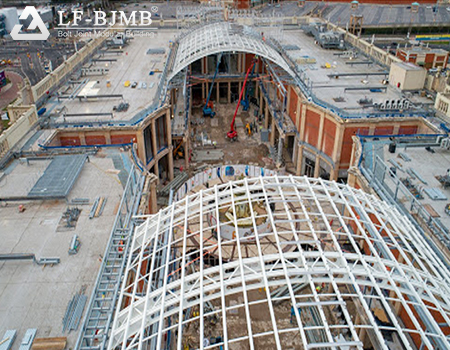
2.Optical properties
(1) Light Transmission
Light transmittance is a key optical performance indicator of glass. In space frame structure buildings, it is usually hoped that the glass can maximize the introduction of natural light to create a bright and transparent indoor space environment. Generally speaking, clear float glass with a light transmission of 85% – 90% can provide good lighting for the interior of a building.
For some buildings with very high light requirements, such as greenhouse mesh structures in botanical gardens and glass display spaces in art museums, it is very important to choose glass with high light transmission.
(2) Sun Shading Coefficient and Reflectivity
The shading coefficient is a measure of the ability of the glass to block heat from the sun. In summer, it is necessary to choose glass with a lower shading coefficient to reduce the transmission of solar radiation heat into the room and reduce air-conditioning energy consumption. For example, the use of coated glass can effectively reflect solar radiation and its shading coefficient can be adjusted according to the type and thickness of the coating.
In terms of reflectivity, appropriate glass reflectivity can avoid the phenomenon of glare and also reduce the heat absorption inside the building to a certain extent. For example, in the glass curtain wall or glass dome of some modern buildings, low reflectivity glass will be used to make the building appearance softer and to reduce light pollution to the surrounding environment.
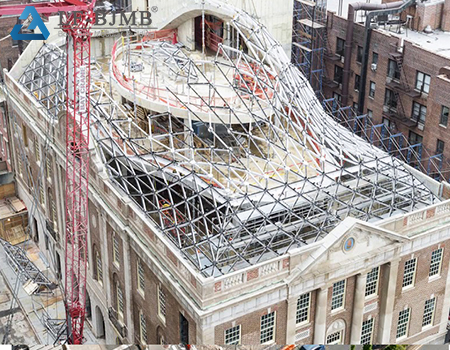
3.Thermal insulation performance
(1) Insulating Glass
Insulating glass is made of two or more pieces of glass, with effective support uniformly separated and sealed by peripheral bonding, so that there is dry gas space formed between the glass layers of glass products. It has good insulating properties because dry air or other inert gases (e.g. argon) form an insulating layer between the glass.
In architectural applications of mesh frame construction, insulating glass can effectively reduce heat transfer between the interior and exterior. For example, in cold regions of the building space frame structure glass wall or glass roof, the use of insulating glass can reduce the loss of indoor heat, improve the building’s thermal insulation performance.
(2) Low-E Glass
Low – E glass is coated with multiple layers of metal or other compound films that provide high reflectivity to far infrared radiation. In winter, it can reflect the indoor heat back to the room, reducing the heat loss to the outdoors; in summer, it can reflect the outdoor solar radiation heat, reducing the air conditioning load.
This kind of glass is widely used in the space frame structure of energy-saving buildings, such as some high-end office buildings, hotels, glass domes or glass curtain walls, the use of Low-E glass can not only meet the lighting needs, but also to achieve a good thermal insulation effect, to improve the building’s energy efficiency.



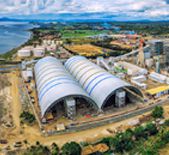

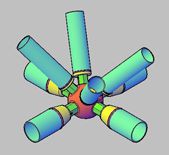
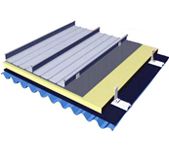
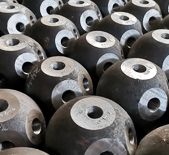



 About Us
About Us 2025-04-21
2025-04-21


